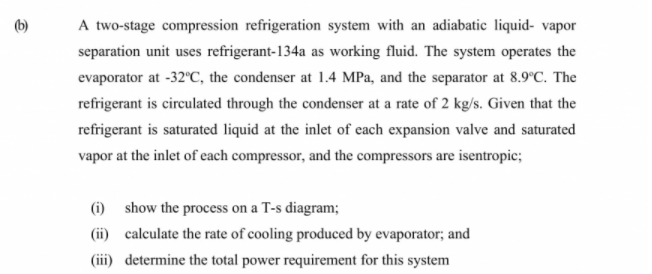A two-stage compression refrigeration system with an adiabatic liquid- vapor separation unit uses refrigerant-134a as working fluid. The system operates the evaporator at -32°C, the condenser at 1.4 MPa, and the separator at 8.9°C. The refrigerant is circulated through the condenser at a rate of 2 kg/s. Given that the refrigerant is saturated liquid at the inlet of each expansion valve and saturated vapor at the inlet of each compressor, and the compressors are isentropic;
A two-stage compression refrigeration system with an adiabatic liquid- vapor separation unit uses refrigerant-134a as working fluid. The system operates the evaporator at -32°C, the condenser at 1.4 MPa, and the separator at 8.9°C. The refrigerant is circulated through the condenser at a rate of 2 kg/s. Given that the refrigerant is saturated liquid at the inlet of each expansion valve and saturated vapor at the inlet of each compressor, and the compressors are isentropic;
Refrigeration and Air Conditioning Technology (MindTap Course List)
8th Edition
ISBN:9781305578296
Author:John Tomczyk, Eugene Silberstein, Bill Whitman, Bill Johnson
Publisher:John Tomczyk, Eugene Silberstein, Bill Whitman, Bill Johnson
Chapter22: Condensers
Section: Chapter Questions
Problem 7RQ: When a standard-efficiency air-cooled condenser is used, the condensing refrigerant will normally be...
Related questions
Question
please soon

Transcribed Image Text:A two-stage compression refrigeration system with an adiabatic liquid- vapor
separation unit uses refrigerant-134a as working fluid. The system operates the
evaporator at -32°C, the condenser at 1.4 MPa, and the separator at 8.9°C. The
refrigerant is circulated through the condenser at a rate of 2 kg/s. Given that the
refrigerant is saturated liquid at the inlet of each expansion valve and saturated
vapor at the inlet of each compressor, and the compressors are isentropic;
(1) show the process on a T-s diagram;
(ii) calculate the rate of cooling produced by evaporator; and
(iii) determine the total power requirement for this system
Expert Solution
This question has been solved!
Explore an expertly crafted, step-by-step solution for a thorough understanding of key concepts.
This is a popular solution!
Trending now
This is a popular solution!
Step by step
Solved in 5 steps with 5 images

Knowledge Booster
Learn more about
Need a deep-dive on the concept behind this application? Look no further. Learn more about this topic, mechanical-engineering and related others by exploring similar questions and additional content below.Recommended textbooks for you

Refrigeration and Air Conditioning Technology (Mi…
Mechanical Engineering
ISBN:
9781305578296
Author:
John Tomczyk, Eugene Silberstein, Bill Whitman, Bill Johnson
Publisher:
Cengage Learning

Refrigeration and Air Conditioning Technology (Mi…
Mechanical Engineering
ISBN:
9781305578296
Author:
John Tomczyk, Eugene Silberstein, Bill Whitman, Bill Johnson
Publisher:
Cengage Learning